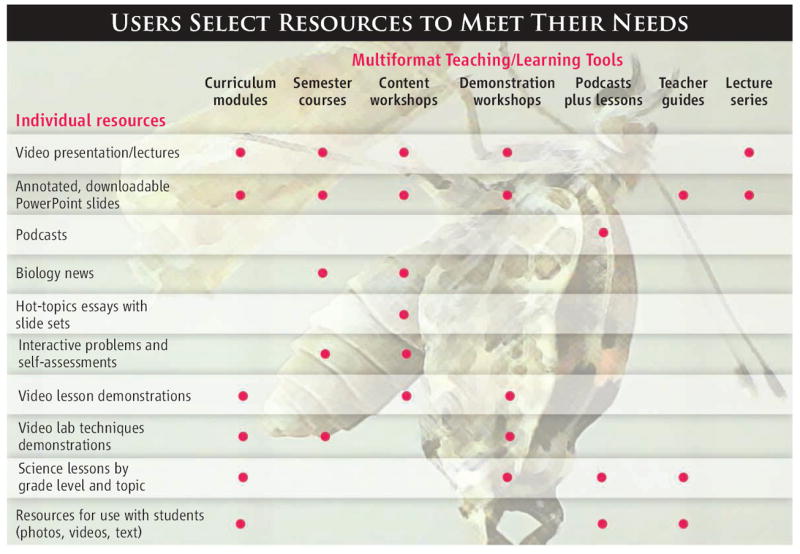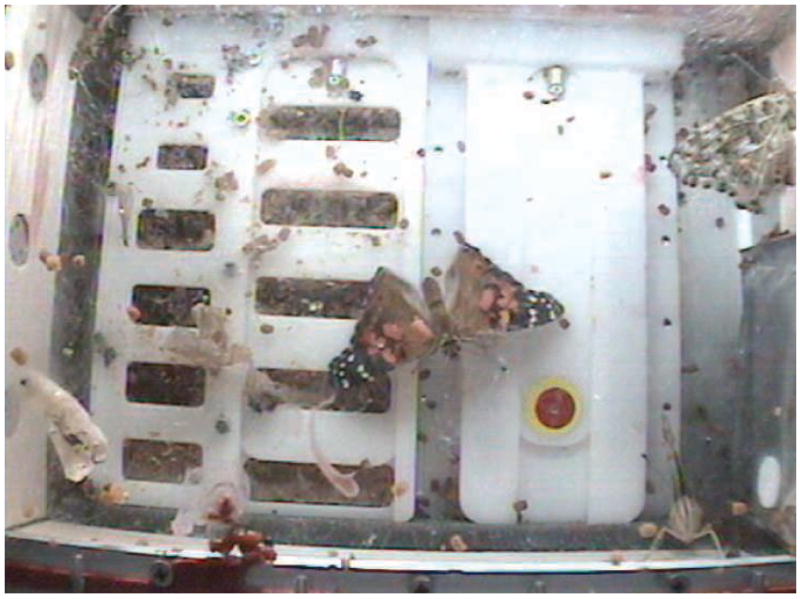Given the pace at which the scientific landscape changes, even practicing scientists can find it difficult to keep up with advances outside their fields of specialization. Imagine the daily challenge faced by classroom science teachers, who are trying to remain current with a broad range of scientific content and to incorporate the new information into existing curricula. This integration requires a depth and breadth of science knowledge not provided by the professional development available to most elementary, and even some secondary, school teachers.
In the United States today, there are 250,000 K–12 (kindergarten to high school) math and science teachers and 1.5 million elementary school teachers (many of whom provide science instruction) (1, 2). Their needs vary widely, and most have insufficient access to quality continuing education and teaching resources. Secondary-school science teachers need up-to-date content and training in laboratory techniques, such as how to use a micro-pipettor. Elementary teachers need help with basic understandings and teaching approaches across a wide range of topics, from earthquakes to the carbon cycle. These challenges are heightened in schools with significant populations of economically disadvantaged and at-risk students, where teachers tend to be less prepared to teach science (3).
BioEd Online (www.bioedonline.org) and K8 Science (www.k8science.org) are Web sites developed by Baylor College of Medicine (BCM) to address teachers’ needs for accurate, timely science information and teaching materials. The sites capitalize on the Internet’s capacity to reach many users at a relatively low cost. As 97% of U.S. schools report having broadband Internet connections, lack of access is no longer a major concern for potential teacher users (4).
BioEd Online was established in 2004, as a resource for biologists making a career transition, via alternative certification, to secondary school science teaching. The site proved useful and was expanded to serve a wider audience, including all life-science teachers, undergraduate faculty, home-schooling families, and the general public. BioEd Online enables an instructor to learn about a topic such as light microscopy, to download a related lesson, and watch a demonstration on how to teach the lesson, all within a single Web site.
BioEd Online’s asynchronous (any time, anywhere) approach allows large numbers of users to select and access specific online information and resources that meet their own immediate needs (see table, above). For example, a chemistry teacher recently reassigned to teach introductory biology might want to complete a short course on classical genetics. Another teacher might seek fresh ideas on the concept of “calorie” for tomorrow’s lesson. We have made a deliberate effort to provide learner-specific information at the moment it is needed.

Recognizing the need to support science instruction in earlier grades, BCM launched a sister site, called K8 Science, in 2007. Both sites now offer a wide variety of materials that help teachers deepen their expertise and teach in ways that promote students’ use of scientific evidence, engagement in scientific discourse, development of science knowledge, and excitement about science. For example, a K8 science lesson comparing the behavior of water drops and oil drops helps students understand water chemistry. Before conducting that lesson, teachers can review related concepts with a short course on the site.
Content on both sites is guided by an editorial board with diverse scientific and educational expertise. New resources are reviewed by at least two editors for content and educational appropriateness. Specialized reviewers are recruited as needed. Site content includes more than 80 streaming video presentations of current science information, instructional strategies, and lesson demonstrations; 785 downloadable PowerPoint slides with notes; biology news; podcasts; online courses; and discussion forums. Content is organized by resource type, and, where appropriate, by topic and grade. Some materials are indexed for multiple grades, and also may be incorporated into courses or units.
BioEd Online and K8 Science were accessed by more than 1.5 million users during the past year, and the numbers continue to grow. During a typical 30-day period (20 September to 21 October 2009) the sites received 162,400 active visitors (5400 per day), who viewed 594,000 pages and downloaded 16,620 lessons and related files (5). Because teachers access the sites through different Internet service providers, it is not possible to document how many users are in schools. However, the number of lesson downloads suggests that teachers are using the sites. About 63% of users are identifiable as from the United States.
BioEd Online and K8 Science offer a growing number (over 120) of free downloadable (PDF) lessons and science inquiry modules developed by BCM educators and scientists for use with students. Most of these teaching materials were produced by federally funded curriculum development projects and field-tested in schools with teachers and groups of 150 to more than 1000 students. In recent field tests, students instructed by teachers using BCM-developed lessons showed statistically significant increases in science content knowledge, as compared with students in similar classroom settings who were not instructed by teachers using the materials (6, 7).
Web-based dissemination reaches large audiences at lower cost and enables rapid distribution of programs and products. This efficiency contributed to the success of the Butterflies in Space project, a collaboration of BioServe Space Technologies (University of Colorado), BCM, the U.S. National Space Biomedical Research Institute, and the U.S. National Aeronautics and Space Administration (NASA) (see the figure, below). Lesson materials, photos, and videos of Painted Lady butterflies living on the International Space Station during November and December 2009 were posted on BioEd Online and K8 Science. Students were able to access this content in near real time and then design their own experiments to compare space-based organisms with specimens living in their own classrooms. Close to 2900 teachers (representing 172,000 students in 23 countries) registered their classes to participate in the project, which offered a first-hand view of the butterflies’ life cycle and attempts to fly in microgravity.
The Butterflies in Space project.

A recently emerged Painted Lady butterfly spreads its wings on the International Space Station, amid specks of floating waste. BioEd Online disseminated related teaching materials and photos to classrooms around the world.
Partnerships expand the breadth and depth of resources on BioEd Online and K8 Science. Members of several BCM departments have provided presentations, content for courses, or editorial review. Partnerships with Nature and EarthSky Communications have allowed us to make content written for general or scientific audiences more useful to teachers by linking it to education standards and lessons. We are collaborating with the Houston Independent School District to enhance a year-round, face-to-face elementary teacher professional development program with customized online science content and lessons. The Web-based resources are matched, by grade level and topic (such as “magnets” or “animal behavior”), to the district’s entire elementary school curriculum.
The most comprehensive offering thus far on BioEd Online is Genes, Health, and Society, a complete asynchronous course designed for high school teachers and undergraduate students. It covers a range of genetics topics, including biomedical applications of genomics. The course’s first module was piloted with 28 undergraduate “pre-med” majors, 27 of whom reported that they were either “satisfied” or “very satisfied” with the overall experience. Learning gains demonstrated by students on matched before-and-after multiple-choice assessments were statistically significant. We are using the Genes, Health, and Society model to develop courses for teachers on cell and molecular biology and physical science, earth and space sciences, and environmental health science.
The challenges facing the U.S. science education community are of national importance. How do we bolster the science knowledge and teaching skills of thousands of teachers, each with unique professional development and classroom teaching needs? How do we accommodate multifarious local requirements for curriculum, content, and resources? And how do we address these issues in cost- and time-efficient ways? Online approaches are not the only answer to our nation’s science education challenges, but they represent an important strategy for our collective response as a science community.
Acknowledgments
Supported by Houston Endowment Inc.; Howard Hughes Medical Institute 51006084 and 51004102; Science Education Partnership Awards R25 RR18605 and R25 RR13454, National Center for Research Resources (NIH); National Space Biomedical Research Institute NASA NCC 9-58; National Institute of Environmental Health Sciences (NIH) R25 ES10698; National Science Foundation DRL-0723433 and DGE-0440525; Robert Wood Johnson Foundation 57363; National Heart, Lung, and Blood Institute (NIH) R25 HL75747; National Institute of Allergy and Infectious Diseases (NIH) R25 AI084826; RGK Foundation; the Powell Foundation; and the Houston Independent School District. We thank BCM’s Center for Collaborative and Interactive Technologies, School of Allied Health Sciences, and Evenings with Genetics; the Baylor–University of Texas Houston Center for AIDS Research; EarthSky Communications, Inc; Nature Publishing Group; BioServe Space Technologies; Children’s Museum of Houston; Texas A&M University; and the American Physiological Society. Special thanks to J. P. Denk.
Biographies

Nancy P. Moreno editorial director of BioEd Online and K8 Science, received a Ph.D. in biology from Rice University. She is Professor of Allied Health Sciences and Family and Community Medicine and is senior associate director of the Center for Educational Outreach at BCM, where her work focuses on science education partnerships, including the use of Web-based approaches.

Deanne B. Erdmann received her B.S. and M.S. in biology from Stephen F. Austin State University. She was a biology teacher for 29 years and science department chair for 9 years before joining the Center for Educational Outreach at BCM, where she is assistant professor of Allied Health Sciences and managing editor of BioEd Online and K8 Science.
Footnotes
SPORE, Science Prize for Online Resources in Education; www.sciencemag.org/special/spore/
References and Notes
- 1.National Research Council. Rising Above the Gathering Storm. National Academies Press; Washington, DC: 2007. [Google Scholar]
- 2.U.S. Department of Labor. Occupational Outlook Handbook, 2008–2009 Edition. McGraw-Hill; New York: 2009. www.bls.gov/oco/ocos069.htm#emply. [Google Scholar]
- 3.National Science Board. Science and Engineering Indicators 2010. National Science Foundation; Arlington, VA: 2010. [Google Scholar]
- 4.U S National Center for Educational Statistics. http://nces.ed.gov/fastfacts/display.asp?id=46.
- 5.Data from WebTrends Analytics. www.WebTrends.com.
- 6.Moreno N, et al. CBE Life Sci Educ. 2004;4:122. [Google Scholar]
- 7.Moreno NP, Tharp BZ. In: Teaching Science in the 21st Century. Rhoton J, Shane P, editors. NSTA Press; Arlington, VA: 2006. pp. 292–305. [Google Scholar]


